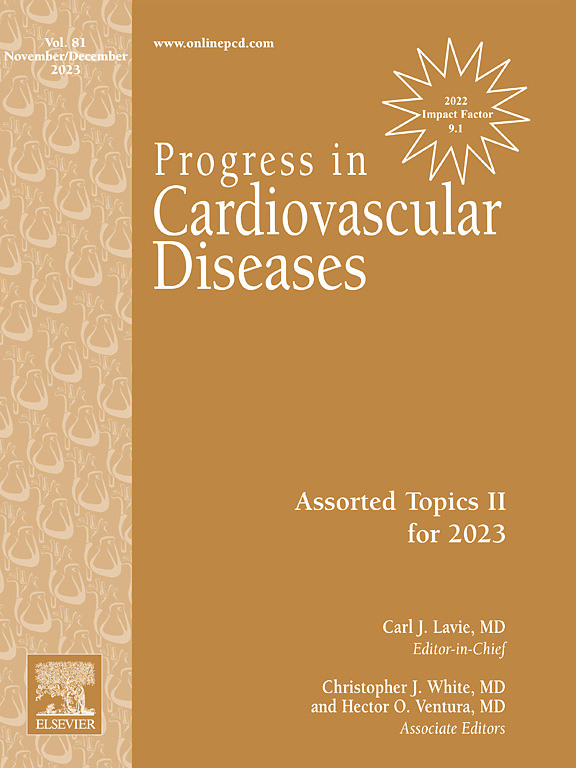腰臀比改变脂蛋白的心血管风险(a):来自MESA的见解
IF 7.6
2区 医学
Q1 CARDIAC & CARDIOVASCULAR SYSTEMS
引用次数: 0
摘要
目的:评估腰臀比(WHR)等肥胖指标是否改变了脂蛋白(a) [Lp(a)]与动脉粥样硬化性心血管疾病(ASCVD)的关系。方法:来自多民族动脉粥样硬化研究(MESA)的4652名参与者分组如下:Lp(a) 结果:与对照组相比,孤立升高的Lp(a) ≥ 50 mg/dl或WHR≥90% pct与ASCVD风险无显著相关性(风险比(HR), 1.15, 95 %置信区间(CI): 0.94-1.39)和(HR, 1.14, 95 % CI: 0.92-1.41)。相反,Lp(a)≥50 mg/dl和WHR≥90%的合并升高与ASCVD风险相关(HR, 2.34, 95 % CI: 1.61-3.40)。Lp(a)≥50 mg/dl与第1和第2分位的ASCVD风险无显著相关性(HR, 1.06, 95 % CI: 0.72-1.48, HR, 1.08, 95 % CI: 0.79-1.48)。然而,在WHR最高分位数中,Lp(a)≥50 mg/dl与ASCVD风险显著相关(HR, 1.60, 95 % CI: 1.23-2.09)。(交互p = 0.01)。体重指数(BMI)和Lp(a)组合在最高风险类别中导致ASCVD的风险相似(HR, 1.33, 95 % CI: 1.00-1.77),没有显著的相互作用(p = 0.99)。结论:在MESA中,WHR显著改变与Lp相关的ASCVD的风险(a)。腹部脂肪的测量可能会进一步细化Lp(a)升高个体的心血管风险。本文章由计算机程序翻译,如有差异,请以英文原文为准。
Waist to hip ratio modifies the cardiovascular risk of lipoprotein (a): Insights from MESA
Aims
To assess if adiposity measures such as waist-to-hip ratio (WHR) modify the relationship of lipoprotein (a) [Lp(a)] with atherosclerotic cardiovascular disease (ASCVD).
Methods
4652 participants from the Multi-Ethnic Study of Atherosclerosis (MESA) were grouped as follows: Lp(a) < 50 mg/dl and WHR <90th percentile(pct) (reference); Lp(a) < 50 mg/dl and WHR ≥90th pct; Lp(a) ≥ 50 mg/dl and WHR <90th pct; and Lp(a) ≥50 mg/dl and WHR ≥90th pct. Cox proportional hazard models assessed the relationship of Lp(a) and WHR with time to ASCVD events.
Results
Compared to the reference group, isolated elevated Lp(a) ≥ 50 mg/dl or WHR ≥90th pct were not significantly associated with risk of ASCVD (hazard ratio (HR), 1.15, 95 % confidence interval (CI): 0.94–1.39) and (HR, 1.14, 95 % CI: 0.92–1.41), respectively. In contrast, the combination of elevated Lp(a) ≥50 mg/dl and WHR ≥90th pct was associated with ASCVD risk (HR, 2.34, 95 % CI: 1.61–3.40). Lp(a) ≥50 mg/dl was not significantly associated with ASCVD risk in the 1st and 2nd tertile of WHR (HR, 1.06, 95 % CI: 0.72–1.48and HR, 1.08, 95 % CI: 0.79–1.48, respectively). However, Lp(a) ≥50 mg/dl was significantly associated with ASCVD risk in the highest tertile of WHR (HR, 1.60, 95 % CI: 1.23–2.09). (Interaction p = 0.01). Body mass index (BMI) and Lp(a) combinations resulted in similar greater risks of ASCVD in the highest risk category (HR, 1.33, 95 % CI: 1.00–1.77), without a significant interaction (p = 0.99).
Conclusions
In MESA, WHR significantly modifies the risk of ASCVD associated with Lp(a). Measures of abdominal adiposity may further refine the cardiovascular risk in individuals with elevated Lp(a).
求助全文
通过发布文献求助,成功后即可免费获取论文全文。
去求助
来源期刊

Progress in cardiovascular diseases
医学-心血管系统
CiteScore
10.90
自引率
6.60%
发文量
98
审稿时长
7 days
期刊介绍:
Progress in Cardiovascular Diseases provides comprehensive coverage of a single topic related to heart and circulatory disorders in each issue. Some issues include special articles, definitive reviews that capture the state of the art in the management of particular clinical problems in cardiology.
 求助内容:
求助内容: 应助结果提醒方式:
应助结果提醒方式:


